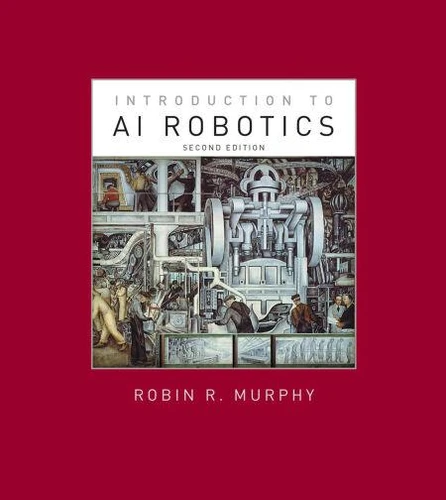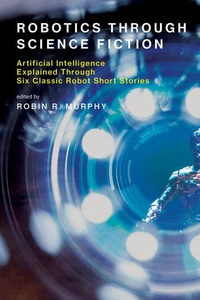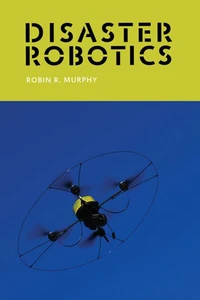Introduction to AI Robotics, second edition
Par :Formats :
Disponible dans votre compte client Decitre ou Furet du Nord dès validation de votre commande. Le format ePub protégé est :
- Compatible avec une lecture sur My Vivlio (smartphone, tablette, ordinateur)
- Compatible avec une lecture sur liseuses Vivlio
- Pour les liseuses autres que Vivlio, vous devez utiliser le logiciel Adobe Digital Edition. Non compatible avec la lecture sur les liseuses Kindle, Remarkable et Sony
- Non compatible avec un achat hors France métropolitaine
 , qui est-ce ?
, qui est-ce ?Notre partenaire de plateforme de lecture numérique où vous retrouverez l'ensemble de vos ebooks gratuitement
Pour en savoir plus sur nos ebooks, consultez notre aide en ligne ici
- Nombre de pages648
- FormatePub
- ISBN978-0-262-34815-7
- EAN9780262348157
- Date de parution01/10/2019
- Protection num.Adobe DRM
- Taille160 Mo
- Infos supplémentairesepub
- ÉditeurBradford Books
Résumé
A comprehensive survey of artificial intelligence algorithms and programming organization for robot systems, combining theoretical rigor and practical applications. This textbook offers a comprehensive survey of artificial intelligence (AI) algorithms and programming organization for robot systems. Readers who master the topics covered will be able to design and evaluate an artificially intelligent robot for applications involving sensing, acting, planning, and learning.
A background in AI is not required; the book introduces key AI topics from all AI subdisciplines throughout the book and explains how they contribute to autonomous capabilities. This second edition is a major expansion and reorganization of the first edition, reflecting the dramatic advances made in AI over the past fifteen years. An introductory overview provides a framework for thinking about AI for robotics, distinguishing between the fundamentally different design paradigms of automation and autonomy.
The book then discusses the reactive functionality of sensing and acting in AI robotics; introduces the deliberative functions most often associated with intelligence and the capability of autonomous initiative; surveys multi-robot systems and (in a new chapter) human-robot interaction; and offers a "metaview" of how to design and evaluate autonomous systems and the ethical considerations in doing so.
New material covers locomotion, simultaneous localization and mapping, human-robot interaction, machine learning, and ethics. Each chapter includes exercises, and many chapters provide case studies. Endnotes point to additional reading, highlight advanced topics, and offer robot trivia.
A background in AI is not required; the book introduces key AI topics from all AI subdisciplines throughout the book and explains how they contribute to autonomous capabilities. This second edition is a major expansion and reorganization of the first edition, reflecting the dramatic advances made in AI over the past fifteen years. An introductory overview provides a framework for thinking about AI for robotics, distinguishing between the fundamentally different design paradigms of automation and autonomy.
The book then discusses the reactive functionality of sensing and acting in AI robotics; introduces the deliberative functions most often associated with intelligence and the capability of autonomous initiative; surveys multi-robot systems and (in a new chapter) human-robot interaction; and offers a "metaview" of how to design and evaluate autonomous systems and the ethical considerations in doing so.
New material covers locomotion, simultaneous localization and mapping, human-robot interaction, machine learning, and ethics. Each chapter includes exercises, and many chapters provide case studies. Endnotes point to additional reading, highlight advanced topics, and offer robot trivia.
A comprehensive survey of artificial intelligence algorithms and programming organization for robot systems, combining theoretical rigor and practical applications. This textbook offers a comprehensive survey of artificial intelligence (AI) algorithms and programming organization for robot systems. Readers who master the topics covered will be able to design and evaluate an artificially intelligent robot for applications involving sensing, acting, planning, and learning.
A background in AI is not required; the book introduces key AI topics from all AI subdisciplines throughout the book and explains how they contribute to autonomous capabilities. This second edition is a major expansion and reorganization of the first edition, reflecting the dramatic advances made in AI over the past fifteen years. An introductory overview provides a framework for thinking about AI for robotics, distinguishing between the fundamentally different design paradigms of automation and autonomy.
The book then discusses the reactive functionality of sensing and acting in AI robotics; introduces the deliberative functions most often associated with intelligence and the capability of autonomous initiative; surveys multi-robot systems and (in a new chapter) human-robot interaction; and offers a "metaview" of how to design and evaluate autonomous systems and the ethical considerations in doing so.
New material covers locomotion, simultaneous localization and mapping, human-robot interaction, machine learning, and ethics. Each chapter includes exercises, and many chapters provide case studies. Endnotes point to additional reading, highlight advanced topics, and offer robot trivia.
A background in AI is not required; the book introduces key AI topics from all AI subdisciplines throughout the book and explains how they contribute to autonomous capabilities. This second edition is a major expansion and reorganization of the first edition, reflecting the dramatic advances made in AI over the past fifteen years. An introductory overview provides a framework for thinking about AI for robotics, distinguishing between the fundamentally different design paradigms of automation and autonomy.
The book then discusses the reactive functionality of sensing and acting in AI robotics; introduces the deliberative functions most often associated with intelligence and the capability of autonomous initiative; surveys multi-robot systems and (in a new chapter) human-robot interaction; and offers a "metaview" of how to design and evaluate autonomous systems and the ethical considerations in doing so.
New material covers locomotion, simultaneous localization and mapping, human-robot interaction, machine learning, and ethics. Each chapter includes exercises, and many chapters provide case studies. Endnotes point to additional reading, highlight advanced topics, and offer robot trivia.





